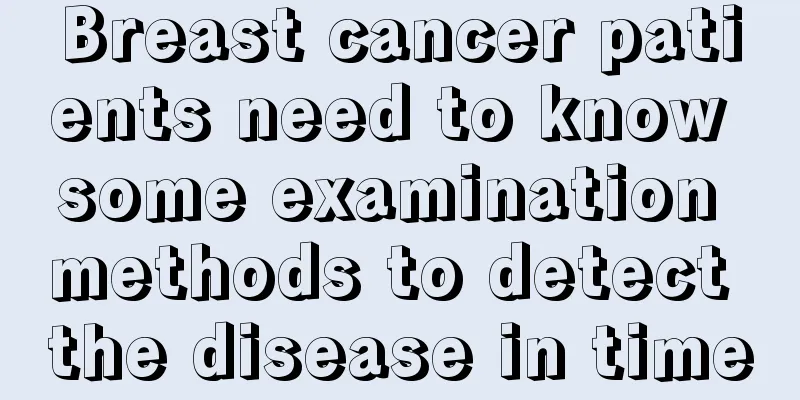What diseases are associated with expiratory dyspnea

|
The happiest thing in life is to have a healthy body. Many people have experienced symptoms such as dyspnea in life. This symptom always makes people feel particularly uncomfortable, but there are many reasons for dyspnea. Only after we understand the cause and diagnose the disease, can we effectively relieve this symptom. Let's learn about the diseases that cause expiratory dyspnea. What diseases are associated with expiratory dyspnea? Pulmonary dyspnea It is caused by respiratory organ diseases and mainly manifests in the following three forms: 1) Inspiratory dyspnea: manifested by wheezing, and depression of the sternum, supraclavicular fossa, and intercostal spaces during inspiration - the three-depression sign. It is common in laryngeal and tracheal stenosis, such as inflammation, edema, foreign bodies and tumors. 2) Expiratory dyspnea: prolonged expiratory phase accompanied by wheezing, seen in bronchial asthma and obstructive pulmonary disease. 3) Mixed dyspnea: seen in pneumonia, pulmonary fibrosis, large pleural effusion, pneumothorax, etc. Cardiac dyspnea Common in cardiogenic pulmonary edema caused by left heart failure, its clinical features are: 1) The patient has a history of severe heart disease. 2) Mixed dyspnea, more obvious in supine position and at night. 3) Medium and small wet gong sounds may be heard at the bottom of the lungs and vary with body position. 4) X-ray examination: abnormal changes in the cardiac shadow; congestion in the hilum of the lung and its vicinity or signs of pulmonary edema. Toxic breathing difficulties Acidosis caused by various reasons can increase carbon dioxide in the blood and decrease pH, stimulate peripheral chemoreceptors or directly excite the respiratory center, increase respiratory ventilation, and manifest as deep and severe dyspnea. Poisoning with respiratory depressants such as morphine and barbiturates can also inhibit the respiratory center, causing shallow and slow breathing. Hematogenous dyspnea Severe anemia can cause shortness of breath due to a decrease in red blood cells and lack of blood oxygen, especially after activity. In case of massive hemorrhage or shock, ischemia and a drop in blood pressure stimulate the respiratory center and cause breathing difficulties. Neuropsychiatric and myopathic dyspnea Severe brain diseases such as encephalitis, cerebrovascular accident, brain tumors, etc. directly affect the respiratory center, causing abnormal respiratory rhythm and leading to dyspnea; myasthenia gravis crisis causes respiratory muscle paralysis, leading to severe dyspnea; in addition, hysteria can also cause dyspnea attacks, which are characterized by significantly fast and shallow breathing. Respiratory alkali poisoning is often accompanied by tetany. After understanding the diseases that cause expiratory dyspnea, we know that dyspnea is generally caused by diseases such as bronchitis and asthma. In fact, if we can maintain good living habits in normal times, we can alleviate this symptom. We must pay attention to a balanced diet, exercise more often, and enhance the body's immunity to reduce illness. |
<<: The role of coronary angiography
>>: What should we pay attention to in the rehabilitation training of triple ankle fracture
Recommend
Cervical cancer is the natural enemy of women, and it is the natural enemy of "cervical cancer"!
At present, cervical cancer has become a very ser...
What are the symptoms of rhinitis?
Many people have suffered from rhinitis in their ...
Why is it easy to grow fat on the waist
A woman's abdomen is an area where fat easily...
What are the ingredients of coffee?
Coffee is a very important drink in life and a ve...
Tips for keeping healthy in spring: do 5 things to avoid getting sick
As the saying goes, a year's plan begins with...
What tea can get rid of bad breath
In life, many people like to drink tea. Some peop...
What are the hazards of air quality to human body
With the rapid expansion of the economy and the a...
Can nasopharyngeal carcinoma cause jaw joint pain?
Can nasopharyngeal cancer cause jaw pain? 1. Pati...
Cerebral hemorrhage compresses the brain stem
Cerebral hemorrhage is a very serious disease bec...
Take a deep breath and your chest hurts like you are choking on food
Sometimes, when we take a deep breath, we feel pa...
Which inner pot is good for electric pressure cooker
Electric pressure cooker is a combination of elec...
How does periodontal abscess come about?
Periodontal abscess is also a type of periodontit...
Efficacy of Flammulina velutipes
Enoki mushrooms are a kind of food that many peop...
How long can the first polio vaccine be delayed?
The polio vaccine is usually injected according t...
Can I have a child if I have low platelets?
An anime called "Cells at Work!" that h...









